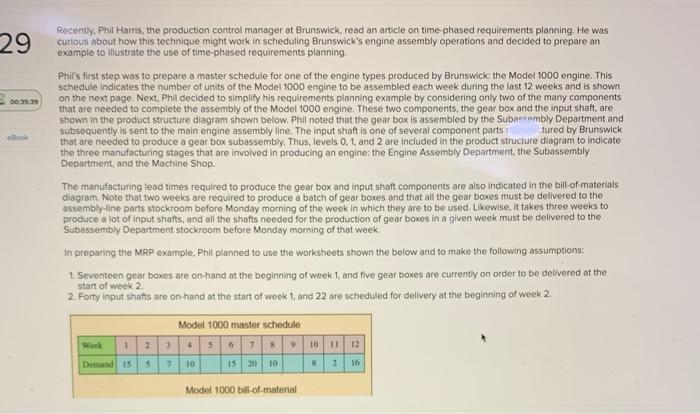29 00:35:39 eBook Recently, Phil Harris, the production control manager at Brunswick, read an article on time-phased requirements planning. He was curious about how this technique might work in scheduling Brunswick's engine assembly operations and decided to prepare an example to illustrate the use of time-phased requirements planning. Phil's first step was to prepare a master schedule for one of the engine types produced by Brunswick: the Model 1000 engine. This schedule indicates the number of units of the Model 1000 engine to be assembled each week during the last 12 weeks and is shown on the next page. Next, Phil decided to simplify his requirements planning example by considering only two of the many components that are needed to complete the assembly of the Model 1000 engine. These two components, the gear box and the input shaft, are shown in the product structure diagram shown below. Phil noted that the gear box is assembled by the Subassembly Department and subsequently is sent to the main engine assembly line. The input shaft is one of several component parts retured by Brunswick that are needed to produce a gear box subassembly. Thus, levels 0, 1, and 2 are included in the product structure diagram to indicate the three manufacturing stages that are involved in producing an engine: the Engine Assembly Department, the Subassembly Department, and the Machine Shop. The manufacturing lead times required to produce the gear box and input shaft components are also indicated in the bill-of-materials diagram. Note that two weeks are required to produce a batch of gear boxes and that all the gear boxes must be delivered to the assembly-line parts stockroom before Monday morning of the week in which they are to be used. Likewise, it takes three weeks to produce a lot of input shafts, and all the shafts needed for the production of gear boxes in a given week must be delivered to the Subassembly Department stockroom before Monday morning of that week. in preparing the MRP example, Phil planned to use the worksheets shown the below and to make the following assumptions: 1. Seventeen gear boxes are on-hand at the beginning of week 1, and five gear boxes are currently on order to be delivered at the start of week 2. 2. Forty input shafts are on-hand at the start of week 1, and 22 are scheduled for delivery at the beginning of week 2. Work 1 2 Demand 15: Model 1000 master schedule 3 4 5 6 7 10 8 9 10 11 12 8 1 16 15 20 10 Model 1000 bill-of-material 29 00:35:25 Initially, assume that Phil wants to minimize his inventory requirements. Assume that each order will be only for what is required for a single period. Calculate the net requirements and planned order releases for the gear boxes and input shafts. Assume that lot sizing is done using lot-for-lot. Gear Box Requirements Week: Gross Requirements Scheduled Receipts Projected Avaliable Balance Net Requirements Planned Order Receipt Planned Order Release Input Shaft Requirements Week Gross Requirements Scheduled Recept Projected Available Balance Net Requirements Planned Order Receipt Planned Order Raase 1 1 15 2 5 3 3 7 4 4 10 5 5 6 6 15 7 7 20 O 8 1 10 9 9 10 10 8 11 11 2 12 12 16 29 00:35:39 eBook Recently, Phil Harris, the production control manager at Brunswick, read an article on time-phased requirements planning. He was curious about how this technique might work in scheduling Brunswick's engine assembly operations and decided to prepare an example to illustrate the use of time-phased requirements planning. Phil's first step was to prepare a master schedule for one of the engine types produced by Brunswick: the Model 1000 engine. This schedule indicates the number of units of the Model 1000 engine to be assembled each week during the last 12 weeks and is shown on the next page. Next, Phil decided to simplify his requirements planning example by considering only two of the many components that are needed to complete the assembly of the Model 1000 engine. These two components, the gear box and the input shaft, are shown in the product structure diagram shown below. Phil noted that the gear box is assembled by the Subassembly Department and subsequently is sent to the main engine assembly line. The input shaft is one of several component parts retured by Brunswick that are needed to produce a gear box subassembly. Thus, levels 0, 1, and 2 are included in the product structure diagram to indicate the three manufacturing stages that are involved in producing an engine: the Engine Assembly Department, the Subassembly Department, and the Machine Shop. The manufacturing lead times required to produce the gear box and input shaft components are also indicated in the bill-of-materials diagram. Note that two weeks are required to produce a batch of gear boxes and that all the gear boxes must be delivered to the assembly-line parts stockroom before Monday morning of the week in which they are to be used. Likewise, it takes three weeks to produce a lot of input shafts, and all the shafts needed for the production of gear boxes in a given week must be delivered to the Subassembly Department stockroom before Monday morning of that week. in preparing the MRP example, Phil planned to use the worksheets shown the below and to make the following assumptions: 1. Seventeen gear boxes are on-hand at the beginning of week 1, and five gear boxes are currently on order to be delivered at the start of week 2. 2. Forty input shafts are on-hand at the start of week 1, and 22 are scheduled for delivery at the beginning of week 2. Work 1 2 Demand 15: Model 1000 master schedule 3 4 5 6 7 10 8 9 10 11 12 8 1 16 15 20 10 Model 1000 bill-of-material 29 00:35:25 Initially, assume that Phil wants to minimize his inventory requirements. Assume that each order will be only for what is required for a single period. Calculate the net requirements and planned order releases for the gear boxes and input shafts. Assume that lot sizing is done using lot-for-lot. Gear Box Requirements Week: Gross Requirements Scheduled Receipts Projected Avaliable Balance Net Requirements Planned Order Receipt Planned Order Release Input Shaft Requirements Week Gross Requirements Scheduled Recept Projected Available Balance Net Requirements Planned Order Receipt Planned Order Raase 1 1 15 2 5 3 3 7 4 4 10 5 5 6 6 15 7 7 20 O 8 1 10 9 9 10 10 8 11 11 2 12 12 16








